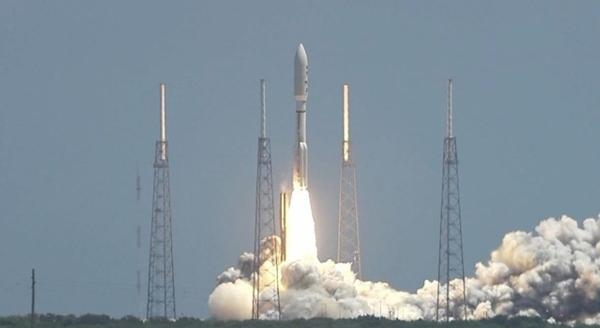Sat, Aug 06, 2011
Lifts Off From Cape Canaveral Air Force Station in
Florida.
NASA's solar-powered Juno spacecraft lifted off from Cape
Canaveral Air Force Station in Florida at 1225 EDT Friday to
begin a five-year journey to Jupiter. Juno's detailed study of the
largest planet in our solar system will help reveal Jupiter's
origin and evolution. As the archetype of giant gas planets,
Jupiter can help scientists understand the origin of our solar
system and learn more about planetary systems around other
stars.
Image Courtesy NASA TV

"Today, with the launch of the Juno
spacecraft, NASA began a journey to yet another new frontier," NASA
Administrator Charles Bolden said. "The future of exploration
includes cutting-edge science like this to help us better
understand our solar system and an ever-increasing array of
challenging destinations."
After Juno's launch aboard an Atlas V rocket, mission controllers
now await telemetry from the spacecraft indicating it has achieved
its proper orientation, and that its massive solar arrays, the
biggest on any NASA deep-space probe, have deployed and are
generating power. "We are on our way, and early indications show we
are on our planned trajectory," said Jan Chodas, Juno project
manager at NASA's Jet Propulsion Laboratory in Pasadena, Calif. "We
will know more about Juno's status in a couple hours after its
radios are energized and the signal is acquired by the Deep Space
Network antennas at Canberra."
Juno will cover the distance from Earth to the moon (about 250,000
miles) in less than one day's time. It will take another five years
and 1,740 million miles to complete the journey to Jupiter. The
spacecraft will orbit the planet's poles 33 times and use its
collection of eight science instruments to probe beneath the gas
giant's obscuring cloud cover to learn more about its origins,
structure, atmosphere and magnetosphere, and look for a potential
solid planetary core.
With four large moons and many smaller moons, Jupiter forms its
own miniature solar system. Its composition resembles that of a
star, and if it had been about 80 times more massive, the planet
could have become a star instead. "Jupiter is the Rosetta Stone of
our solar system," said Scott Bolton, Juno's principal investigator
from the Southwest Research Institute in San Antonio. "It is by far
the oldest planet, contains more material than all the other
planets, asteroids and comets combined, and carries deep inside it
the story of not only the solar system but of us. Juno is going
there as our emissary -- to interpret what Jupiter has to say."
Juno's name comes from Greek and Roman mythology. The god
Jupiter drew a veil of clouds around himself to hide his mischief,
and his wife, the goddess Juno, was able to peer through the clouds
and reveal Jupiter's true nature.
More News
Aviation Governance Secured...At Least For a While The National Business Aviation Association similarly applauded the passage of the FAA's recent reauthorization, contentedly recou>[...]
Emphasis On Growing The Future of Aviation Through Concentration on 'AFFORDABLE FLYERS' It's been a number of years since the Latest Edition of Jim Campbell's HUGE SportPlane Resou>[...]
Amazilia Aerospace GmbH, Develops Digital Flight Control, Flight Guidance And Vehicle Management Systems Textron eAviation has acquired substantially all the assets of Amazilia Aer>[...]
Honeywell's Primus Brings New Tools and Niceties for Hawker Operators Hawker 4000 business jet operators have a new installation on the table, now that the FAA has granted an STC f>[...]
Company Celebrates Niche-but-Important Advancement in Industry Standards Echodyne has announced full integration of its proprietary 'EchoFlight' radar into the e American Aerospace>[...]
 Bolen Gives Congress a Rare Thumbs-Up
Bolen Gives Congress a Rare Thumbs-Up The SportPlane Resource Guide RETURNS!!!!
The SportPlane Resource Guide RETURNS!!!! Buying Sprees Continue: Textron eAviation Takes On Amazilia Aerospace
Buying Sprees Continue: Textron eAviation Takes On Amazilia Aerospace Hawker 4000 Bizjets Gain Nav System, Data Link STC
Hawker 4000 Bizjets Gain Nav System, Data Link STC Echodyne Gets BVLOS Waiver for AiRanger Aircraft
Echodyne Gets BVLOS Waiver for AiRanger Aircraft



